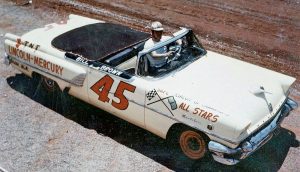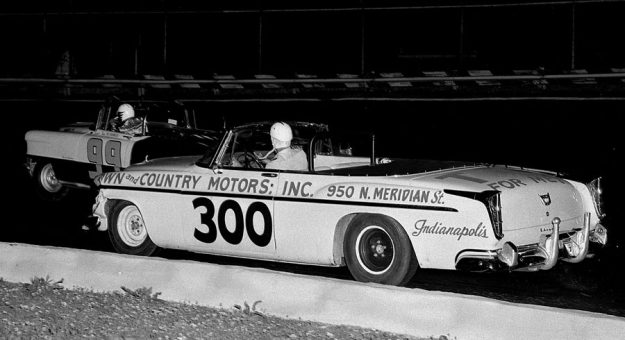SAFE stood for the Society of Autosport, Fellowship and Education and during the first part of the 1950s, the organization went toe to toe with NASCAR, the American Automobile Ass’n and the Midwest Ass’n for Race Cars in sanctioning stock car racing.
In 1952, Chicago native Chuck Scharf came up with the idea of running late model stock cars on Midwestern short tracks. Scharf, who along with his partner-at-the-time Eddie Anderson, introduced short-track, stock car racing to the Chicago area in 1948 with a few cars from Scharf’s used car lot competing at Gill Stadium on Chicago’s southeast side.
The SAFE stock cars competed for the first time at Blue Island’s Raceway Park on Wednesday night, July 16, 1952. A SAFE press release noted, “Only feature race winners and track record holders will be eligible to compete in the inaugural Circuit of Champions race at Raceway Park. The 18-car, 50-lap feature will be further limited to stock cars of 1949 to 1952 models.”
“This is the first time show room races have been staged on a quarter-mile track with no doctoring (modifications),” said Raceway Park public relations man Warren Pursell in the Chicago Sun Times.
Bud Koehler, who lived minutes away from the track, drove a 1950 Nash to the checkered flag, grabbing the inaugural SAFE contest ahead of Bob Pronger in a ’51 Ford and Bryant Tucker in a Buick. All three drivers were Raceway Park regulars with Koehler having already garnered championships at the speedway in stock cars and midgets.
Next up on the SAFE schedule was a 50-lapper at Ohio’s Cincinnati Race Bowl with Texas driver Pat Kirkwood scoring the win in his ’50 Oldsmobile. Kirkwood finished ahead of Chicago’s Bill Brown, who drove a 1949 Ford.
Dubbed the “Flying Cowboy,” Kirkwood was the fastest qualifier for the February 1952 event on Florida’s Daytona Beach. He piloted a 1951 Chrysler to a speed of 110.97 mph. Racing on the beach and on Highway A1A, Kirkwood finished third in the NASCAR Grand National contest, trailing winner Marshall Teague and runner-up Herb Thomas.
Kirkwood was crowned the 1952 SAFE stock car champion after racing at tracks such as Motor City Speedway in Detroit, 16th Street Speedway in Indianapolis and Toledo (Ohio) Speedway. Several visits by the series to Raceway Park, which was just south of Chicago’s city limits, included a “dead-heat” finish between Kirkwood and Don Oldenberg after 100 laps of the tight, quarter-mile paved oval.

Seeing a dozen or so shows run in 1952, SAFE expanded its schedule to more than 30 events in 1953 with Kirkwood again claiming the title. Again wheeling an Oldsmobile, Kirkwood won at 16th Street Speedway, Broadway Speedway in Tennessee, Riverside Speedway in Arkansas, Oakland Stadium in Missouri, Playland Park in Iowa, Buffalo Civic Stadium in New York and Greenville Speedway in Tennessee, as well as at Grand Rapids, Mich., Jeffersonville, Ind., and Nashville, Tenn.
Kirkwood earned the 1953 SAFE title ahead of Hershel White, Jack Harrison, Don Oldenberg and Mason Bright. A couple of highlights from the year included Harrison winning a 500-lap race at New York’s Buffalo Civic Stadium on Sept. 19 and Oldenberg closing out the season with a 100-lap victory at Chicago’s Soldier Field on Sept. 27.
Kirkwood, in a ’54 Oldsmobile, Harrison, wheeling a ’54 Ford, Oldenberg, in a ’54 Buick, and Bob Pronger, driving a ’54 Cadillac, were among the winners on the SAFE tour in 1954 with Harrison unseating Kirkwood for the year’s SAFE championship.
Harrison finished ahead of Oldenberg, Hershel White, Pronger and Kirkwood. Kirkwood won eight of the circuit’s first 10 races held in 1954 but was suspended from competition for several weeks in August. The series saw over 40 events held.
Highlights of the season included Pronger winning a 200-lap chase at the Buffalo Civic Center; White scoring an impressive 250-lap victory at the Michigan State Fairgrounds in Detroit; and Oldenberg and Bill Lutz finishing up the year with victories in Florida.
Operating out of SAFE’s Indianapolis office, Scharf and partner Harry Redkey called for the series to be for convertibles only in 1955 with early regulations stating, “chrome roll bars mandatory.”
The SAFE Circuit of Champions All Stars tour opened at the Alabama State Fairgrounds in Birmingham with Bill Brown and his ’55 Mercury Montclair convertible scoring the victory in the 100-lap headliner.
More than 30 races in 20 states were held with Oldenberg claiming the SAFE driving championship. Oldenberg guided his ’55 Buick to the title over Bill Brown, Darel Dieringer, Bill Cornwall and Art Binkley.
Highlights of the season included Bright’s 250-lap win at the one-mile dirt Michigan State Fairgrounds oval and Oldenberg and fellow Indiana driver Red DuVall closing the year with victories in Georgia and Florida, respectively.
In December 1955, the merger of SAFE with NASCAR was announced with Oldenberg being named the defending champion of NASCAR’s new convertible division, which sanctioned races from 1956 through ’59.
What became of SAFE’s champions?
Oldenberg, for many years, owned a successful automotive/truck garage and towing business – Oldenberg and Son Inc. in Gary, Ind. During his racing career, Oldenberg met a young A.J. Foyt, who competed in a SAFE event at Oklahoma’s Taft Stadium in 1955. Oldenberg died in 1983 at the age of 60.
After his racing days were over, Kirkwood operated The Cellar — a so-called “beatnik” coffee shop in Fort Worth, beginning in 1959. A real estate broker later in life, Kirkwood died in 2001 at the age of 73.
Known as the “Flying Farmer,” Harrison, SAFE’s 1954 champion, passed away in 1956 from a ruptured stomach ulcer.
He was only 27 years old.
